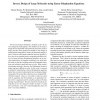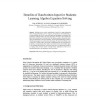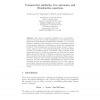2008 search results - page 71 / 402 » Computing with Equations |
CSB
2005
IEEE
14 years 2 months ago
2005
IEEE
We have previously developed a method [1] for the inverse design of small ligands. This method can be used to design novel compounds with optimized properties (such as drugs) and ...
ICDE
2008
IEEE
14 years 10 months ago
2008
IEEE
We introduce Pulse, a framework for processing continuous queries over models of continuous-time data, which can compactly and accurately represent many real-world activities and p...
AIED
2007
Springer
14 years 3 months ago
2007
Springer
Building on past results establishing a benefit for using handwriting when entering mathematics on the computer, we hypothesize that handwriting as an input modality may be able to...
LPAR
2005
Springer
14 years 2 months ago
2005
Springer
The notion of comparative similarity ‘X is more similar or closer to Y than to Z’ has been investigated in both foundational and applied areas of knowledge representation and r...
EOR
2006
13 years 9 months ago
2006
We propose a multivariate statistical framework for regional development assessment based on structural equation modelling with latent variables and show how such methods can be c...



